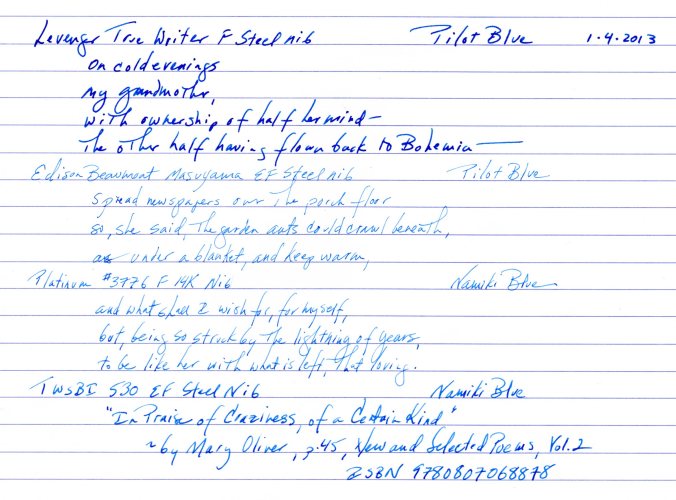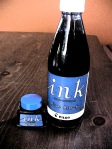Note: an update to this post appears February 1, 2013.
Assumptions are dangerous things to make, and like all dangerous things to make — bombs, for instance, or strawberry shortcake — if you make even the tiniest mistake you can find yourself in terrible trouble. Making assumptions simply means believing things are a certain way with little or no evidence that shows you are correct, and you can see at once how this can lead to terrible trouble. For instance, one morning you might wake up and make the assumption that your bed was in the same place that it always was, even though you would have no real evidence that this was so. But when you got out of your bed, you might discover that it had floated out to sea, and now you would be in terrible trouble all because of the incorrect assumption that you’d made. You can see that it is better not to make too many assumptions, particularly in the morning.”
― Lemony Snicket, The Austere Academy
 For over a year, Namiki Blue has been my daily blue ink. I was never so grateful for its water resistance properties when a desk accident occured spilling—pouring!—water everywhere. A handwritten project came through the soaking unscathed. The only reminders of the accident are a few warped pages.
For over a year, Namiki Blue has been my daily blue ink. I was never so grateful for its water resistance properties when a desk accident occured spilling—pouring!—water everywhere. A handwritten project came through the soaking unscathed. The only reminders of the accident are a few warped pages.
Flow Issues with Some Pens
That said, a frustrating issue with Namiki Blue came to light. My normally wet writing Levenger True Writer ran very dry using Namiki blue. The pen refused to write after 24 hours of being inked. Considering that Namiki Blue works great in all my other pens, I put the True Writer aside after a thorough flushing/cleaning of the pen. I forgot about this tempermental pen moment.
Then last fall a friend sent me some of his pens to play with. None of his pens would write with Namiki Blue. In fact, I thought his pens were duds. Then the Levenger True Writer nudged at me, and I re-inked the TW with Namiki Blue. Same problem. No flow. Worse even than before. Hmmmmm. I flushed all the pens and put them aside for a couple of days.
Re-inking all aforementioned recalcitrant pens, this time with Pilot Blue-Black, each one wrote beautifully, without issue. Hmmmmm. Fascinating, eh?
All of these pens are well cared for, and are thoroughly flushed between inks. That is, as thorough as one can be without using an ultrasonic cleaner.
During my initial evaluation it seemed to me Namiki Blue looked and performed the same as Pilot Blue. In order to double check that earlier evaluation, I bought some more Pilot Blue from Japan. Verdict? The Pilot Blue runs a little dry in the Japanese style EF nibs at my disposal. In one instance after 24 hours of being inked with Pilot Blue, a pen was hard starting. The Levenger TW, well, so far so good. Of course, I’ll let ya know if that changes, eh?
 I’ve long assumed that Namiki and Pilot Blue were the same ink with different packaging for different parts of the world. “Assumptions are dangerous things,” to re-quote Lemony Snicket. The inks may or may not be the same formula. Hey, maybe I just bought a particularly dry batch of Namiki Blue bottles.
I’ve long assumed that Namiki and Pilot Blue were the same ink with different packaging for different parts of the world. “Assumptions are dangerous things,” to re-quote Lemony Snicket. The inks may or may not be the same formula. Hey, maybe I just bought a particularly dry batch of Namiki Blue bottles.
I share the potential “dryness” or flow issue with Namiki and Pilot Blue because, well, that’s what we fountain pen people do. Obsessively. Your own experiences may vary (YMMV), as we also like to say. Please note: I still like this basic blue very much.
☮ →Update: Be aware that this ink will “feather” on some papers. True, too, of Namiki or Pilot Black. Not so true, IMHO, of Pilot Blue-Black.

Pilot and Namiki Blue
Because you won’t remember an earlier post, A Daily Blue, I’ll repeat my personal criteria for a daily writing ink:
- Coffee drip resistance.
- An agreeable color to moi.
- Fast dry time (3-5 seconds).
- No bleed-through on 28# Staples (FSC) laser paper or Staples Sustainable Earth/Bagasse notepads. (Please note—mostly fine and extra fine nibs for moi.)
- Must perform well in all pens in my tiny collection—not always so easy to achieve!
- Complete cost (includes shipping if buying online) under $.20 per ml of ink.
Namiki Blue has served those criteria for my pen hoard quite well. However, be warned the tale of my Levenger True Writer: Namiki Blue can be persnickety in some pens! To quote our friends at Pendemonium:
“Inks and Pens Can Be Quirky! …Not all inks work equally in all pens…”
[And above all,] “Don’t panic…”
Pilot Blue-Black to the Rescue
While Namiki or Pilot Blue retains a place in my ink repertoire, Pilot Blue-Black now dominates my ink supply. Yes, merely because of this persnickety ink and pen combination! Pilot Blue-Black has not failed in any of my pens. (Then again, see above thoughts from Pendemonium.)
Since finding A Daily Blue, I’ve discovered that 350ml bottles of Pilot inks (Red, Black, and Blue-Black) can be sourced from Japan for around $.11 per ml. That cost includes shipping from Japan. This was far cheaper than my last purchase of Namiki Blue at approximately $.16 per ml. (The world keeps changing with fluctuating prices and shipping costs, n’est-ce pas?)
The 350ml bottles are refill bottles. They are not meant to fill your pen from them. I use a 30ml Pilot bottle to fill my pens from. Obviously, you can use whatever empty bottle you like to fill from the large “soda pop” shaped 350ml bottle.
Note: Pilot Blue is not available in the 350ml bottles. Only Black, Red, and Blue-Black can be had in 350ml. (Thank you, Thomas, for catching my error in this regard!)
 Pilot Blue-Black bottled ink is not available for sale in the USA. (Nor are Pilot branded Blue or Red bottles.) You can buy Blue-Black via eBay, JetPens, or Rakuten. Strangely enough, Pilot/Namiki Blue-Black cartridges are available in the USA. If carts are your thing, then you will find that color readily available to you. The ink qualities are the same. So, uh, one assumes…
Pilot Blue-Black bottled ink is not available for sale in the USA. (Nor are Pilot branded Blue or Red bottles.) You can buy Blue-Black via eBay, JetPens, or Rakuten. Strangely enough, Pilot/Namiki Blue-Black cartridges are available in the USA. If carts are your thing, then you will find that color readily available to you. The ink qualities are the same. So, uh, one assumes…

Progress Report on Ink Hoarding
Meanwhile if you’re wondering if I’ve managed to nip the ink hoarding in the nib, see for yourself:

# of bottles as of Dec 31, 2012
The two J. Herbin bottles (Lierre Sauvage and Cacao du Bresil) are less than half full. The Sailor Shu-Chu still nearly full. These are special occasion inks, as are the two boxes of cartridges I broke down and bought. One in Platinum Pigment Blue. The other, a box of Sailor Sei-Boku. A tale for another time.
Interesting! Who would have known that Pilot and Namiki Blue ink cause hard starting in some pens. And that Pilot Blue Black doesn’t. Thank you for the information.
I personally use and love Pilot Blue Black. Never would have imagined that it behaves differently than even Pilot Blue.
LikeLike
Thanks for your comments, Thomas!
I think this may be a surface tension issue—that the Pilot/Namiki Blue is clinging to the walls of the converter. I’ll try a small bead or somethin’ in my Levenger converter to see if that helps. Hmmmmmmm…..or a drop of glycerin.
LikeLike
Pilot Blue Black is a great ink for daily use. Some are put off by the strong scent but it is pretty water resistant and slime is a remote prospect. I also think that the bottle is perhaps the best I’ve used. Tight seal and an ink reservoir that works with any pen I own.
LikeLike
Thanks for stopping by, Karlo! I hardly notice the chemical smell anymore, and like this ink a great deal. Even Pilot/Namiki Blue. 🙂
Folks: please check out Karlo’s great blog, “And All Other Tasks”
LikeLike
Have you had any luck slightly diluting the ink? I know from my experience with Private Reserve Ebony Green, dilution works wonders for hard starting. I usually dilute this highly saturated ink 50% with distilled water. Even after several weeks without use, pens inked with this write immediately upon contact with paper.
LikeLike
That’s great, Jack! Thanks for commenting with your experience with PR Ebony Green. BTW: I think you’ll find that Namiki Blue is not a saturated ink like your PR ink. Adding water, of course, is a time-honored practice in mixing, diluting and problem solving.
Adding water to ink actually helps to make an ink dry faster. Ink is wetter than water… Rather than act as a lubrication, water dilutes the surfactants (the things that help break up the surface tension) in the ink. And so for my True Writer, I would be inclined to add an ever so micro-tad of glycerine to the ink to increase the flow. I’m not much for ink mixing, diluting or adding things to it, but think I will do an experiment or two for the True Writer and report back.
The True Writer was balky after 48 hours of switching to Pilot Blue. Yet after another 48 hours, it’s written without any hard starting. I’m going to switch it back to Namiki Blue with a tad of glycerin and see what’s what.
P.S. Not at all an expert on ink: All of what I know about ink and water can be easily found on FPN.
P.P.S. Follow-up is here: https://peaceablewriter.wordpress.com/2013/02/01/tale21/
LikeLike